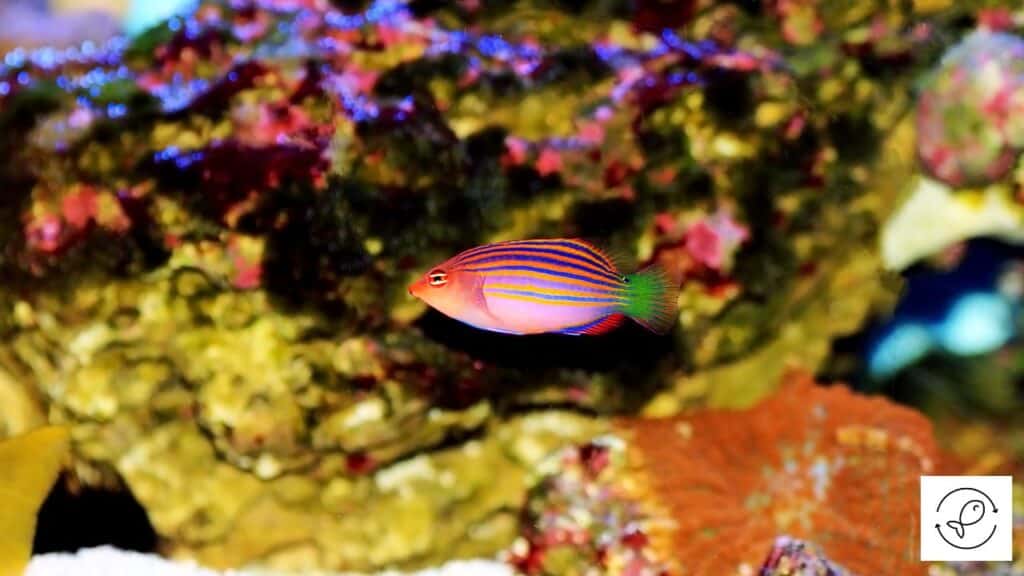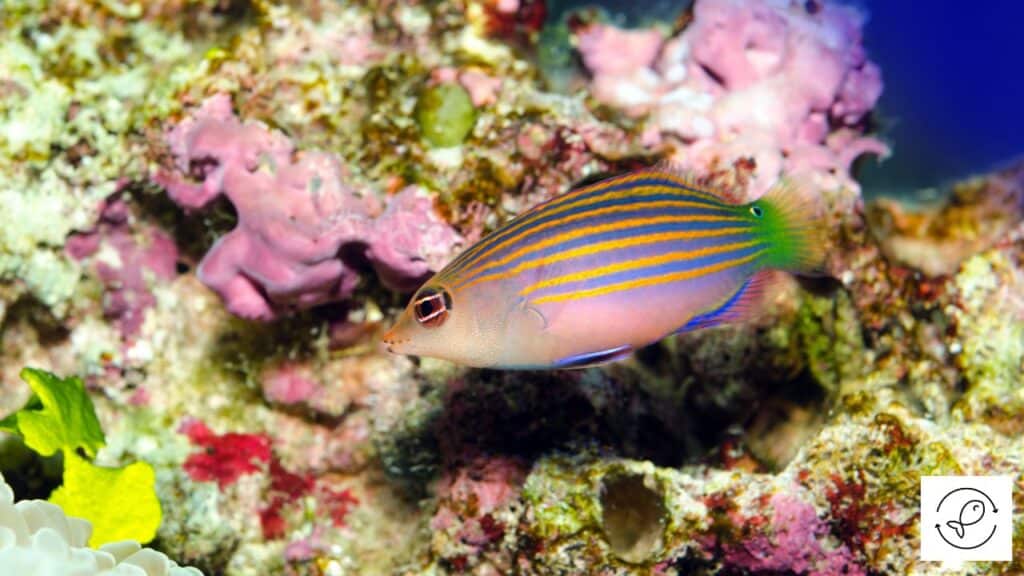Six line wrasses are reef-safe fish as they don’t nip at corals. These fish are native to the reef environment and feel comfortable taking shelter behind the reef branches. However, they’re known to nibble and prey on tiny crustaceans, worms, and mollusks that inhabit the coral reef.
Let’s now understand in more detail why six line wrasses are considered reef-safe.
Reasons Six Line Wrasses Are Considered Reef-Safe
Six line wrasses are small saltwater fish species commonly seen in the Indo-Pacific oceans.
These fish are reef-friendly and well known among aquarists.
They usually occupy the branches on the seaward side of coral reefs. They’re carnivores but don’t nip on the corals.
Given below are some of the reasons why six line wrasses are considered reef-safe.
They Belong to The Reef Environment
The natural habitat of six line wrasses is the coral reef environment in the warm, shallow tropical waters of the Indo-Pacific region.
The water quality and the conditions inside the reef aquarium are similar to their natural environment.
So they feel comfortable and secure inside a reef aquarium.
Six line wrasses spend most of their time foraging through the crevices and crannies of coral reefs, searching for small prey to consume.
They Aren’t a Threat to Corals
Six line wrasses don’t feed on corals or anemones in their natural habitat. It means your corals are safe in your reef tank.
They’re predatory fish that eat a meaty protein-rich diet.
So they will prey on the small invertebrates that inhabit your reef aquarium.
Six line wrasses are also known to graze around the coral and live rocks, eating worms and other small invertebrates.
These fish are known to seek refuge or hide behind the reef branches too.
They’re Compatible with Other Reef-Safe Species
Six line wrasses are considered semi-aggressive fish.
But the fact is, depending on the situation, they’re either aggressive or peaceful.
Six line wrasses are aggressive toward each other and some of the wrasse species.
However, they’re laid-back and peaceful with other common saltwater and reef-safe fish species.
Six line wrasses are compatible with reef-safe fish like the tangs, large clownfish, and angelfish.
However, you must ensure they have plenty of space to move around the reef tank.
Benefits of Keeping Six Line Wrasses in A Reef Aquarium
Six line wrasses live in a reef environment in the ocean.
These small fish have a distinct personality, creating demand for themselves in the aquarium hobby.
Given below are some benefits of keeping six line wrasses in a reef aquarium.
They’re Visually Appealing
Six line wrasses are bright, colorful, and active fish with strong personalities.
They’re more popular than other wrasse species in the aquarium hobby.
These fish get their name because of the six long lines on either side of their body.
These active fish are stunning to watch and enhance the aesthetics of a reef aquarium.
They Aren’t Too Expensive
Six line wrasses aren’t an expensive fish compared to some of the other wrasse and reef species that are commonly found in the aquarium hobby.
These fish are also known to thrive in captivity once they settle in the reef aquarium.
However, you must feed them adequately to make them feel secure and happy.
They Can Handle Varying Conditions

Six line wrasses aren’t difficult to care for, making life easy for fishkeepers to meet their needs.
These hardies can handle varying water conditions.
They can get stressed during transportation to the home aquarium but quickly settle in the new tank.
Six line wrasses are also less susceptible to infections than other marine fish.
However, it’s best to keep the water quality stable and quarantine the new fish or invertebrates to avoid transmission of any infection.
They Remove Parasites from The Tank
Six line wrasses clean the reef tank by eating parasites like pyramid snails, bristle worms, and flatworms that inhabit the tank.
These wrasses also sometimes do a cleaner job of eating the parasites living on the bodies of their tankmates.
They thereby keep the parasite population in check within the aquarium.
Drawbacks of Keeping Six Line Wrasses in A Reef Aquarium
Six line wrasses are reef-safe and will leave your corals alone.
However, they can be unpredictable toward tankmates in certain situations.
Given below are some drawbacks of keeping six line wrasses in a reef aquarium.
They Can Get Aggressive and Territorial
Six line wrasses can display aggression toward other peaceful wrasses and timid fish if they’re not fed adequately or their habitats lack hiding spots.
These fish won’t bother any of your coral or anemones, but they may overwhelm smaller species.
Six line wrasses are even known to push around bigger fish.
They Out-Compete Shy Fish for Food
Six line wrasses need adequate food to thrive.
These predatory fish need a protein-rich diet that can satiate their high nutritional requirements.
These fish compete with tankmates during feeding hours.
They will be active and quickly gobble up the food, out-competing slow and timid tankmates.
Therefore, you must spread the food to different parts of the aquarium so that the sluggish tank inhabitants can get sufficient food.
They Can Attack New Fish
Six line wrasses are an excellent choice for community reef aquariums.
However, they can’t live with their own kind and will also bother other peaceful wrasses.
Six line wrasses may also not welcome the new fish and can bully them by nipping their fins.
So you can try to change the aquarium setup before adding the new fish to curb the aggression of six line wrasses.
This way, six line wrasses will get busy exploring the new setup inside the reef aquarium while the new fish get time to establish themselves in the tank.
They Need a Large Tank Setup
Some aquarists make the mistake of keeping these small fish in a nano tank due to their small size.
Though they can fit in a small tank, it’s not suitable for these wrasses.
These active fish need a large tank with an open swimming space.
They also need intricate rockwork to forage, hide, or seek shelter.

